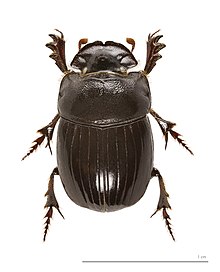
Dung beetles are beetles that feed on feces. Some species of dung beetles can bury dung 250 times their own mass in one night.

Phanaeus vindex, the rainbow scarab, is a North American species of true dung beetle in the family Scarabaeidae. It is found in eastern and central United States and in adjacent far northern Mexico. It is the most widespread species of Phanaeus in the United States and it has a wide habitat tolerance. It may hybridize with the generally less common P. difformis.
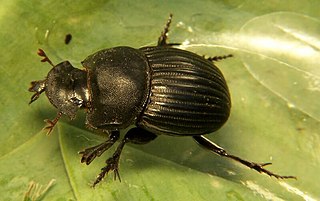
Copris is a genus of dung beetles in the tribe Coprini of the scarab family. It comprises more than 250 tunnelling species and has an almost worldwide distribution.

Deltochilum valgum is a nocturnal, Neotropical species of dung beetle in the family Scarabaeidae, which has evolved a predatory lifestyle. While most other members of the true dung beetle subfamily feed on faeces or decomposing matter, D. valgum is highly specialised for eating millipedes; such a transition from scavenger to carnivore is rare. Whether this is novel adaption in this species or an ancestral adaption in the genus is unclear; at least two other species, Deltochilum kolbei and D. viridescens, which are not particularly closely related to D. valgum, also kill and feed on millipedes.

Onthophagini are a tribe of scarab beetles. Commonly placed in the true dung beetle subfamily (Scarabaeinae), it belongs to a group of subfamilies separated as subfamily Coprinae in some treatments.
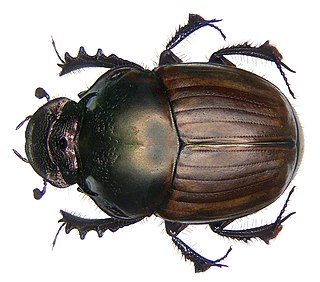
Digitonthophagus is a genus of Scarabaeidae or scarab beetles in the superfamily Scarabaeoidea. It was considered a subgenus of Onthophagus by some authorities. A review of the taxon was published in 2017.

Eurysternus is a genus of Scarabaeinae or dung beetles in the family Scarabaeidae. It is normally placed in the Oniticellini, although some authors consider it the single genus in the tribe Eurysternini (e.g.). It is restricted to the Neotropics and includes 53 recognized species.

Onthophagus is a genus of dung beetles in the Onthophagini tribe of the wider scarab beetle family, Scarabaeidae. It is the most species-rich and widespread genus in the subfamily Scarabaeinae, with a global distribution.

Digitonthophagus gazella is a species of scarab beetle. It belongs to the genus Digitonthophagus, which was promoted from subgenus to genus level in 1959. There has been some confusion regarding the application of the names with many people using the outdated name Onthophagus gazella. Dung beetle experts use the term Digitonthophagus gazella.

Phanaeus, the rainbow scarabs, is a genus of true dung beetles in the family Scarabaeidae, ranging from the United States to northern Argentina, with the highest species richness in Mexico. Depending on species, they can inhabit a wide range of habitats, from tropical to temperate climates and deserts to rainforests. In those living in relatively arid places adults are primarily active during the wet season and those living in relatively cold places are primarily active during the summer. They are excellent diggers and good fliers.
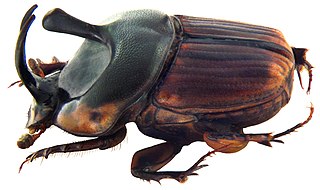
Oniticellini are a tribe of scarab beetles, in the true dung beetle subfamily (Scarabaeinae). Nearly all species of this tribe feed on and nest in dung, mainly that of large herbivores. Most are tunnelers; dung is buried at the ends of tunnels dug below a dropping, and used as food by both adults and larvae; others, known as dwellers make brood cavities within or just beneath the dung.
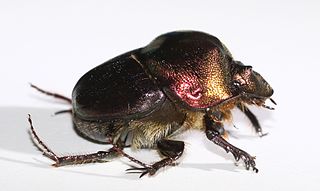
Proagoderus is a genus of Scarabaeidae or scarab beetles in the subfamily Scarabaeinae. It was considered a subgenus of Onthophagus by some authorities. It includes over 100 species native to Africa and Asia.

Coprini is a tribe of scarab beetles, in the dung beetle subfamily (Scarabaeinae). Scholtz et al. describe them as tunnellers that are shiny black, of moderate to large size and with a strongly convex shape. They also, however state that the grouping based on these characteristics has little phylogenetic validity, and the placement of several genera in this and related tribes is likely to change.

Sarophorus is a genus of dung beetles in the tribe Ateuchini of the family Scarabaeidae. It comprises about ten species from Africa.

Phanaeini is a tribe of dung beetles in the family Scarabaeidae. There are about 12 genera and 200 described species in Phanaeini. They are native to the Americas with the highest species richness in the Neotropics. They are mostly coprophagous or necrophagous, but some of the least known genera appear to be myrmecophilous. They are medium-sized to large beetles, often with bright metallic colors, and often with horns on their heads.

Copris fricator is a species of dung beetle in the family Scarabaeidae.
Onthophagus unifasciatus, is a species of true dung beetle native to India and Sri Lanka.
Copris repertus, is a species of dung beetle found in India, Sri Lanka and Myanmar.

Onthophagus dama, is a species of dung beetle found in Nepal, Bhutan, India, and Sri Lanka.
Onthophagus hastifer, is a species of dung beetle found in India, Sri Lanka, Vietnam, Taiwan, Thailand, and Myanmar.
